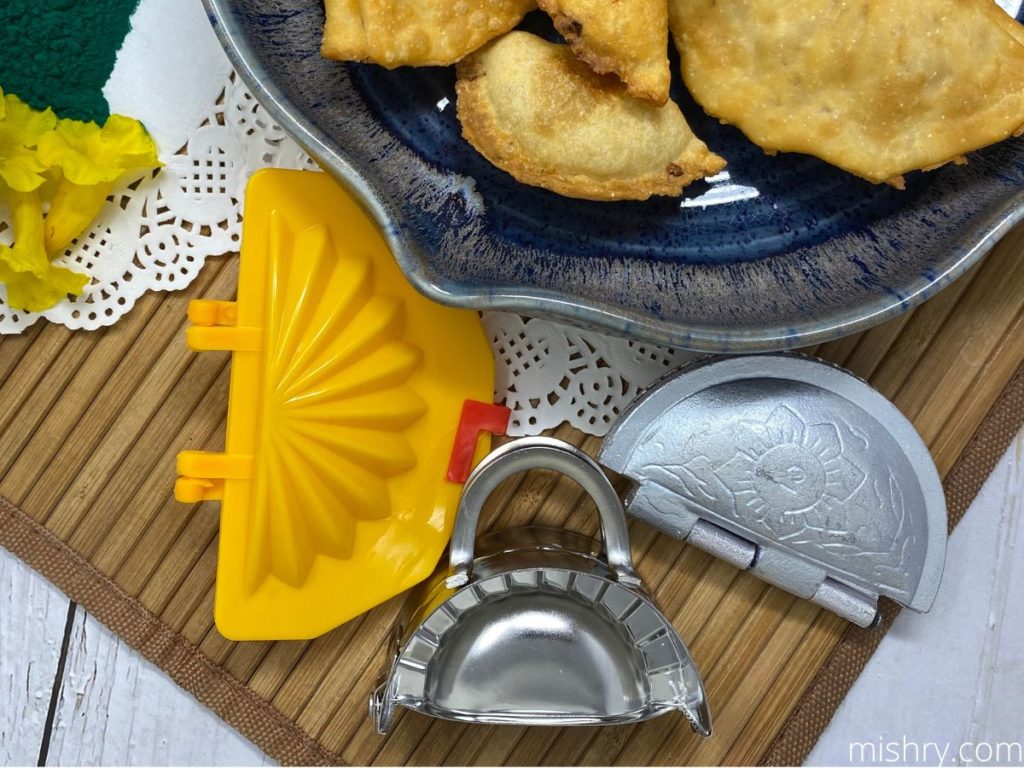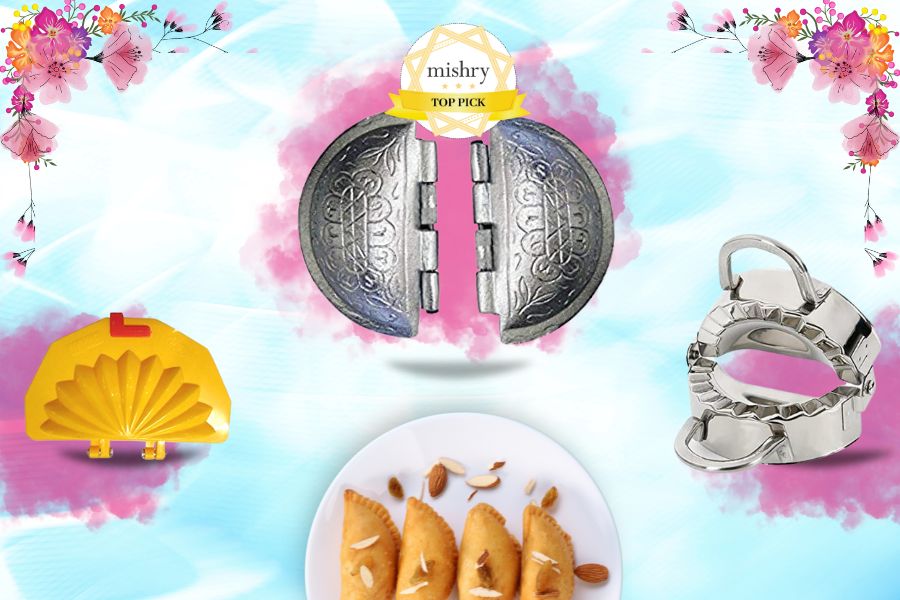Trying something different this year? Curious to know if you can create halwai style gujiyas? All you need is an efficient tool, a fool-proof recipe, and TONS of festive spirit.
To find out the best gujiya makers in India, we placed an order for three moulds – each made from a popular, easily available material (aluminum, steel, and plastic). Which worked best, what were the drawbacks, how did we use them, clean them, everything you need to know has been explained in this review.
Which mould do we recommend and why?
Our Review Factors
What were some of the key parameters for our gujiya maker mould review?
1. Design
This parameter covers aspects like size, shape, the construction, the pattern of the crimp, etc. Additionally, the cavity of the moulds formed a significant sub-parameter here.
Of the three, which yields gujiyas of a shape and size most identical to the store-bought variants?
2. Usability
Typically, large batches (15-20+) gujiyas are prepared in a go. A gujiya maker is not something you’d use for two units and call it a day.
We gauged the ease these tools offer in terms of contraption and usability. Does it get uncomfortable or tiring after a prolonged use?
3. Convenience
Here, we recorded the cleaning and maintaining processes. Which of them is the easiest to clean and store? How much space would they occupy? Any specific steps to be kept in mind?
4. Other Parameters
The price, packaging, overall quality were gauged here.
Gujiya Makers – Review Process, Recipe
We followed a quick, uncomplicated recipe to test the gujiya makers.
For the pastry (shell of gujiyas), we took 300 grams of refined wheat flour (maida), two tablespoons of semolina (suji), 100 grams ghee, and warm water as needed.
For the filling, 100 grams khoya, three tablespoons of sugar, 50 grams desiccated coconut, a handful of almonds, and some cardamom pods were used.
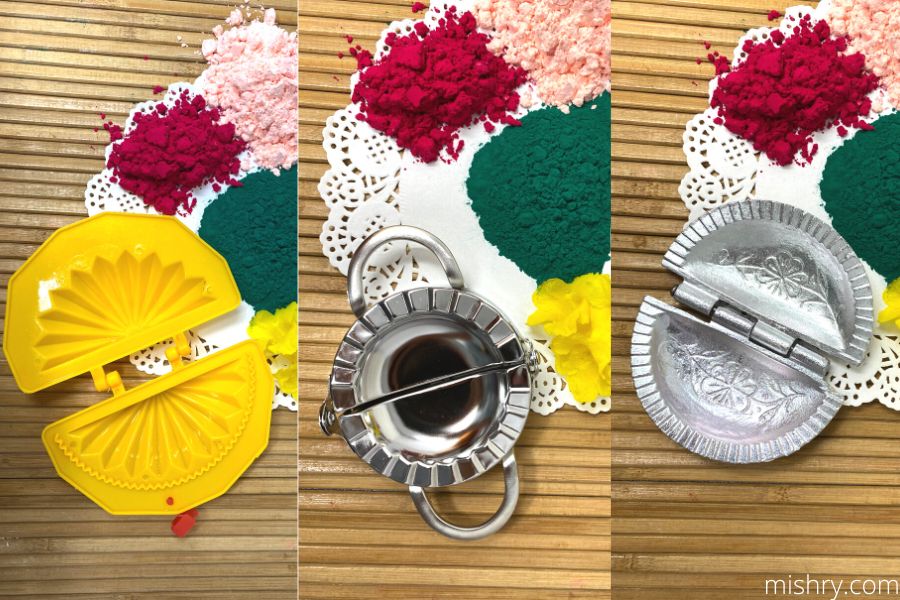
Gujiya Makers – Detailed Review
The following section holds our detailed experience with the three contenders.
1. Aluminum Gujiya Mould – Mishry Top Pick
Our Experience
The aluminum mould was quite lightweight, it didn’t look or feel bulky. Equipped with a medium-sized cavity, this mould had a crimped pattern on the edges with a floral design at the center. This did not have a lock to seal the dough shut and the contraption (joints, connectors) seemed flimsy at first.
To our surprise, this worked quite well. The overall size and cavity of this mould are adequate. It helps make decent-sized gujiyas. The moderate cavity ensures there’s a balance between the two elements of gujiyas (pastry and filling) such that, they don’t feel too doughy or overly stuffed. Moreover, the dough did not stick to the base of the mould.
Straight out of the mould, the gujiyas were sealed well, had the floral impression and were easy to demould. The edges did not open when frying, thumbs up on this. (It can get really messy), however, the floral design disappeared post-frying.
Considering gujiyas are something you prepare in bulk, this mould is easy to use and clean, doesn’t strain your hands and gives consistent results.
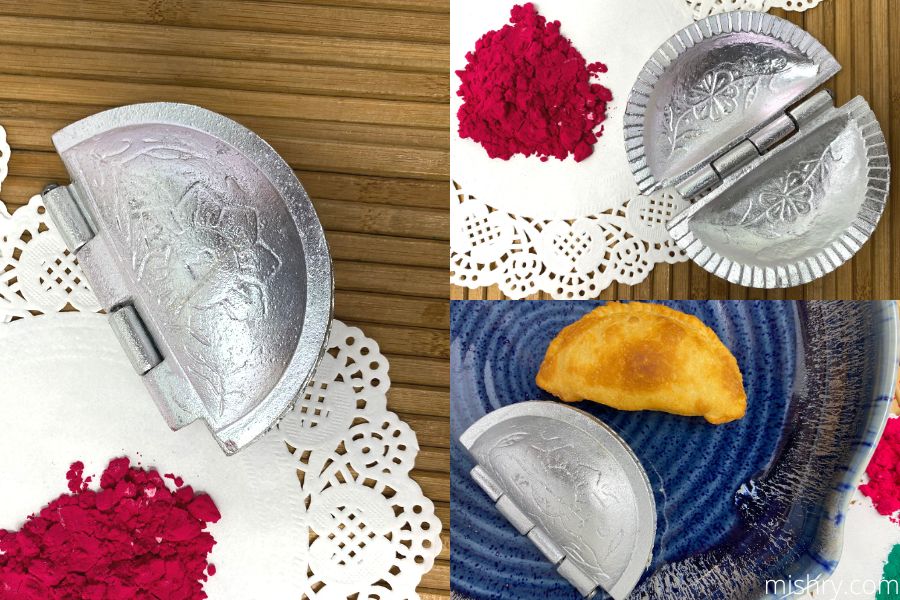
Product Features
This Gujiya maker is priced at Rs 259/- and has two units in a carton.
- Adequately sized
- Lightweight tool
- Performs well
- Dough does not stick to base
- Priced right
If there’s one thing that would ensure a relatively smoother gujiya making session, it would be this aluminum mould.
2. Steel Gujiya Mould
Our Experience
Compared to the aluminum gujiya maker, this mould made of steel was better in terms of construction. It felt sturdy (not too heavy, though) and the screws (contraption) were sturdier. That being said, the size and cavity were questionable. It looked fairly small to help make halwai like gujiyas (images below), but we put it to the test.
The crimped edges were sharp and lent a precise wavy design to the gujiyas we made with this mould. However, removing the excess dough was a challenging task. We’d recommend taking only as much dough as needed. As mentioned above, this is a smaller mould, the cavity was not as deep either. This had an impact on the ratio of pastry to filling, and not a positive one.
To wrap up, while this had a sturdier construction, it did not make the gujiya-making process as easy as the aluminum mould. It would be better suited for making dumpling/momos at home.
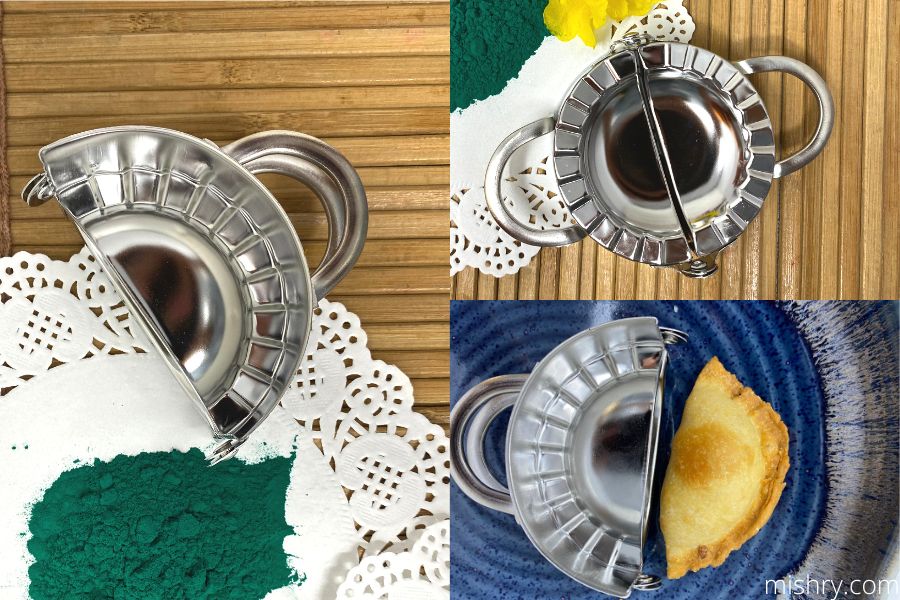
Product Features
This is priced at Rs 280/- for a single-piece.
3. Gujiya Maker Plastic
Our Experience
Moulds made of plastic usually work well and are durable (Like our modak mould). However, that was not the case here. This mould broke as we were shaping the fourth gujiya with it. And this was despite using a light pressure.
This gujiya maker had a small lock which is not of any use. The size was absurd. This mould was so large, it yielded taco-sized gujiyas. But the cavity wasn’t proportional so we ended up with gujiyas that felt very doughy from the edges. This does have an attractive design, but it did not seal the edges of the gujiyas. The gujiyas started opening upon frying, which defeats the entire purpose of making a gujiya in the first place. If sealed manually, it would create a different design on each piece.
Definitely a no-go from our experience!
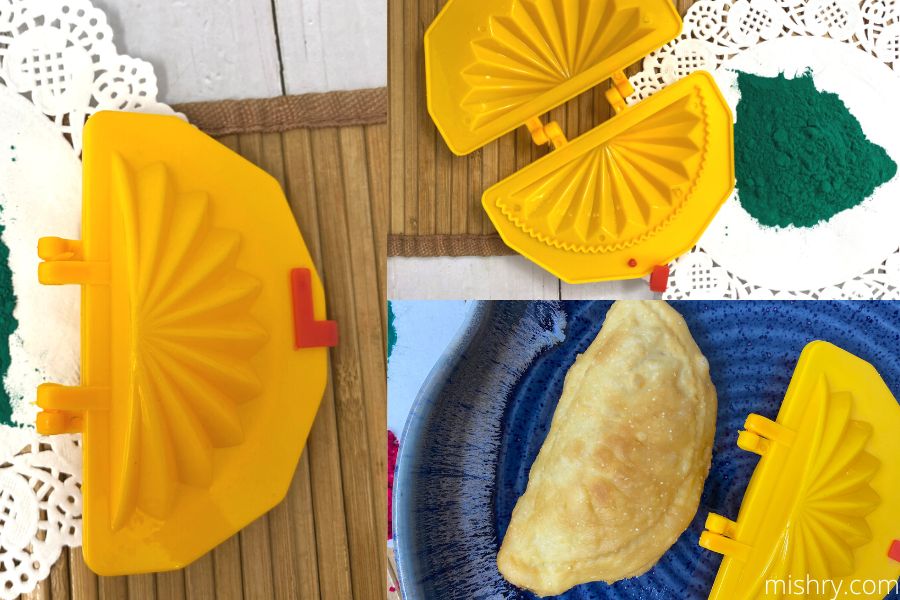
Product Features
Priced at Rs 90/-, this had two units.
- TOO large
- Does not seal well
- Disproportionate cavity to size dimensions
- Not durable
Our Top Picks & Recommendations
Why did we choose the aluminium gujiya maker/mould as our Top Pick?
We recommend the aluminum gujiya maker if you plan to make some at home. Not only will you have appropriately-sized gujiyas, but also ones that look even, appetising, with a nice balance between the cover and stuffing.
It is also very easy to use and clean.
Frequently Asked Questions
Here are some interesting FAQs on Indian gujiya maker.
1. Is this gujiya maker dishwasher safe?
There was no information given on the pack regarding this. We would suggest washing them by hand.
2. Can these gujiya makers be used to make other dishes or snacks?
The steel mould can be used for momos or dumplings and the plastic one for tacos, owing to their sizes.
3. Can children use these gujiya makers under adult supervision?
Yes, they can. It could be a fun, festive activity for them to feel included. It is always advised for children to be supervised by an adult in the kitchen.
4. Which gujiya maker is currently best in town?
We had the best experience with the aluminum mould.
5. Are gujiya makers worth purchasing?
Depending on how often you make them at home, yes, gujiya makers are an economical addition to the kitchen.
Our Verdict
Our gujiya making experience was nothing short of a team building exercise, from preparing the elements to shaping, frying, relishing.
After making more than three dozen gujiyas, we can say that the aluminium mould is the best amongst the three styles we tested. We recommend this mould for its cavity size, easy usability, and overall convenience.
Our reviews are unbiased and all samples used during the reviews were paid for by us. Read our entire ethics statement here.

